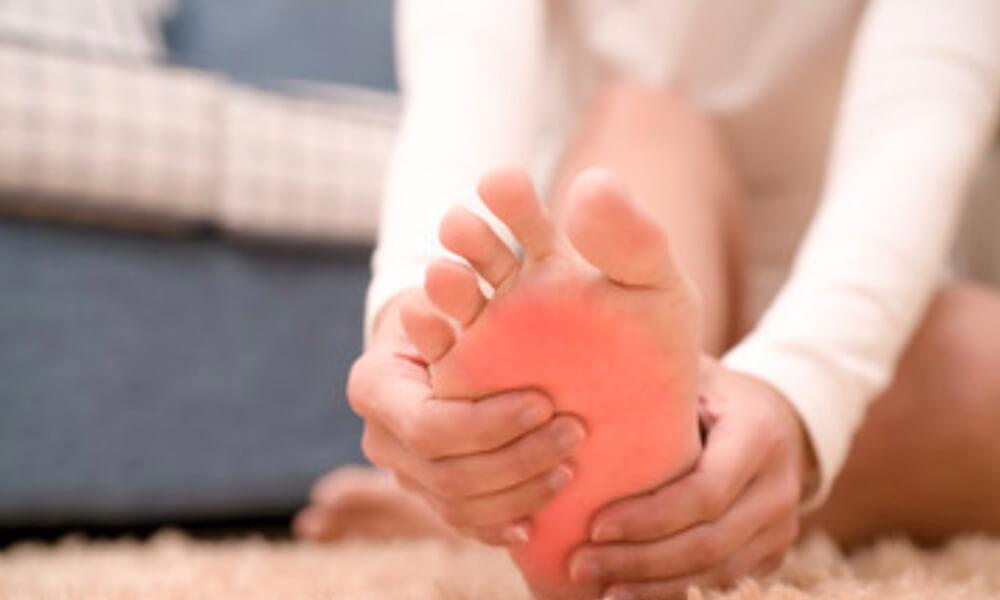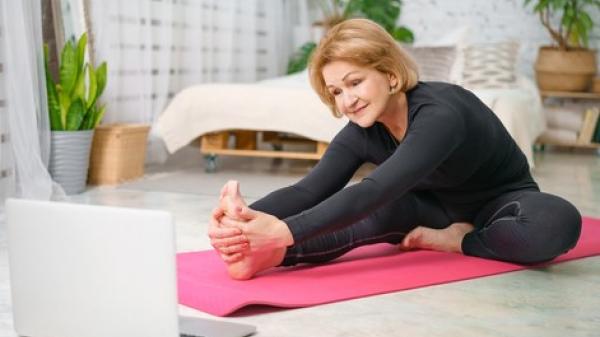
How are ankles and feet affected by arthritis?
People with axial spondyloarthritis (axSpA) can have joints in their ankles, feet and toes affected. Arthritis in the feet can make standing and walking painful. You may find your feet and/or toes change shape, making it harder to fit into shoes. People with axSpA can experience heel pain at the point where the achilles tendon attaches to the back of the heel of the plantar fascia, in the arch of the foot due to enthesitis. Enthesitis is an inflammation of the 'enthesis', the point where a ligament, tendon or the fibrous capsule that encloses the joint attaches to the bone.
Consider different forms of exercise to take pressure off your painful feet. Make sure you have supportive, well-fitting footwear.
Exercise
Exercise is important to keep your joints moving however you may need to try different types of exercise if you have painful feet. For example, consider exercising in water. The buoyancy of the water takes pressure off your ankles and feet and you may find you can move more freely than you can on land. Strength training and cycling are also good forms of exercise that do not put extra pressure on sore feet. It is important to be assessed by a physiotherapist before undertaking a any new exercise, particularly if you have advanced axSpA. If you are walking or standing, make sure you wear supportive, comfortable shoes. A podiatrist (see below) can recommend appropriate footwear.
Weight loss
One of the best ways to take pressure off painful ankles and feet is to lose any extra body weight. Being overweight can make your symptoms worse as your affected joints need to carry more weight. Extra weight can also increase your risk of developing other health issues, such as cardiovascular disease, high blood pressure and type 2 diabetes. It may also impact your ability to respond to medication, making it less effective. The good news is that a drop in weight can improve your joint symptoms, reduce your health risks for other conditions and increase the effectiveness of your medications.
You may find it useful to see a dietitian for advice about healthy eating.
See a podiatrist
Podiatrists specialise in conditions affecting the feet. They can help you with advice about footwear, nail care and orthoses (inserts for your shoes that may help reduce foot pain). You will need a referral from your doctor to see a podiatrist in the public system (such as at a community health centre). These services are usually free or low cost. You can consult a private podiatrist at any time without a referral from your doctor. The Australian Podiatry Association website has helpful information about when to see a podiatrist, common foot problems and advice on footwear. the website can also help you find a podiatrist in your local area.
Footwear
The most important thing you can do to protect your feet is to wear supportive shoes that fit your feet properly. Keep these tips in mind when buying new shoes:
- Ask an experienced footwear salesperson for help in choosing the right shoe and size. Remember, your shoe size may change if your feet are affected by arthritis. If you feet tend to swell during the day, it might be beneficial to have your feet measured when your feet are swollen, to ensure you have footwear with enough room in them.
- Try shoes on with any insoles or orthoses you normally wear. Some orthoses may need extra depth, particularly in the toe area.
- Your toes should not touch the end of your shoes as your toes or nails could become damaged. Make sure there is a 1cm gap at the end of your longest toe.
- Look for shoes with synthetic or rubber soles for better grip and shock absorption.
- Look for shoes that can be secured on to your feet with laces and straps. Fastenings that may be easier to do up include Velcro, elastic shoelaces and zips. There are also many devices to help you put on shoes and do up fastenings. Contact an Independent Living Centre for advice.
If it is difficult to find shoes that fit because of swollen or misshapen joints, try extra depth footwear. Contact your local arthritis office or an Independent Living Centre for retailers or see a podiatrist for advice.
What else can I do?
There are other treatments that may help you deal with pain and stiffness:
- Medicines: Many different types of medicines can help the symptoms of arthritis. Your doctor or pharmacist can help you understand which medicines are right for you and how best to use them.
- Heat and cold: Applying heat, such as a hot pack (microwaveable wheat pack), heating pad or hot water bottle, to stiff, painful joints may help relieve these symptoms. If your joints are hot and swollen, you may find it useful to apply an ice pack. Try applying heat or cold to the painful area for 15 minutes. Always have a layer (such as a tea towel) between your skin and the heat or ice pack. You can repeat this whenever you need to throughout the day. Make sure the temperature of the skin returns to normal in between applying heat or ice packs to prevent damage to the tissues.
- Creams: Applying creams or ointments containing anti-inflammatory medicines or capsaicin (an ingredient in cayenne and chilli peppers) may help control pain. Talk to your doctor or pharmacist about these types of creams.
- Glucosamine and chondroitin: It is unclear if glucosamine or chondroitin are useful for feet affected by arthritis.
- Fish oils: Fish oils may be useful for some forms of arthritis that affect the feet.
- Herbal therapies: There is no conclusive proof that herbal medicines are effective in treating arthritis of the feet.
CONTACT YOUR LOCAL ARTHRITIS OFFICE FOR MORE INFORMATION AND SUPPORT SERVICES.









